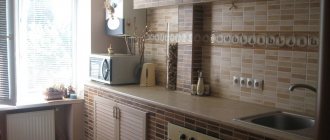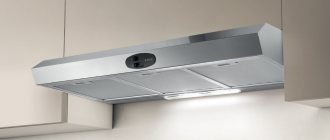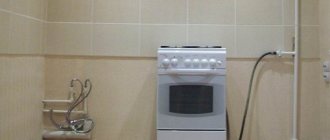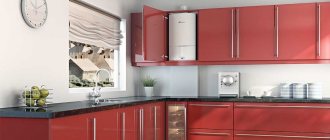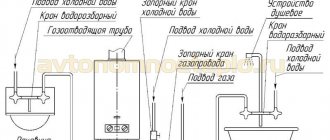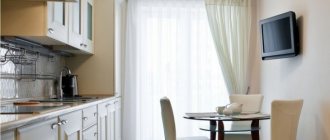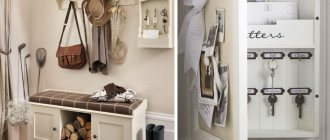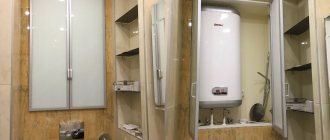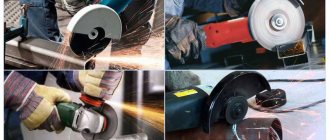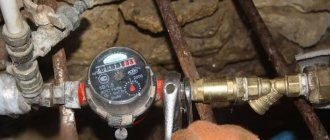Good afternoon, dear reader! Gas is what we use every day in everyday life and what provides us with comfortable life activities: quick preparation and heating of food, heating water and heating the home. Interruptions in its supply are extremely rare, since our country has large reserves of resources and well-designed networks that allow us to avoid large-scale accidents.
But gas supply systems also have a drawback - they are not an aesthetically pleasing type of communication. However, there are many ways to hide a gas pipe in the kitchen without violating the operating rules.
Why hide pipes?
Gas pipes mainly run through the corridor and kitchen of most apartments and private buildings. This makes it possible to gain more direct access to gas, which is used for cooking and heating the room.
However, its not very aesthetic appearance can easily ruin the interior of any room. Therefore, it is necessary in a timely manner, even at the stage of planning the placement of furniture and decorative elements in the kitchen, to also take care of masking gas communications.
Embed into the wall
In this case, it is necessary to perform more manipulations than in the second option, but the result will be very comfortable.
So, an easy way to hide the counter in the wall is to use drywall. In this material it will be quite easy to cut out a convenient window in which the gas meter will be “placed”. In addition, it is convenient to hide wires and pipes under the drywall. Then it turns out that the device is hidden in the wall. And to provide access to the necessary elements, a plastic screen-door or small roller shutters are installed. As a result, the device is not visible, and access to it is convenient, and the interior of the kitchen can be customized to suit every taste.
The second way is to make a niche in the wall itself. But, this procedure is not very convenient and will require a lot of effort, because more channels will need to be made for the pipes. A non-professional is unlikely to be able to do this, and what’s the point if there are good alternatives.
Methods for masking pipes
There are several ways to solve this problem:
- cover the gas pipeline with kitchen furniture. Behind the wall cabinets of the kitchen unit you can completely hide both the pipes and the gas water heater and meter. To do this, dismantle the rear part or remove the side wall of the cabinet. The meter and gas pipe will not take up the entire volume inside the cabinet; there will still be enough space left to store kitchen utensils or food. For a disguise option using wall cabinets, watch the video:
- install a box made of plastic, plasterboard, polycarbonate or chipboard. The box is a lightweight structure that is mounted on a metal frame profile and guides. Its installation will cost less than purchasing a new kitchen set;
- use a railing system. The railing is used to disguise the gas pipe when it runs across the entire width of the wall at the level between the countertop and wall cabinets. This makes it possible to use it as a hanging structure for placing light kitchen utensils, hooks, shelves and drying racks on it. In this case, the pipe is cleaned to a shine, and then covered with chrome paint in several layers;
- decorate pipes. Masking in this way does not require the creation of any structures from various materials, inside of which elements of gas communications will be located. To paint a gas pipeline to match the furniture or wallpaper, you can use any waterproof paint, and also apply decorative painting to the surface of the pipes.
Which way is better
The simplest, most economical and optimal from a safety point of view for masking gas pipes is the decoration method. In this case, there remains free access to the gas communications for preventive inspections and maintenance.
In addition to budget painting, you can use various improvised means and modern finishing materials to decorate gas pipes:
- cardboard sleeve;
- decorative painting;
- interior mosaic;
- wallpapering the pipe;
- decoupage method;
- twine or twine;
- bamboo panels.
Color options
Painting to match the wall. With this approach, the pipes are practically invisible, for example, white walls and a pipe.
A game of contrasts. The use of contrasting solutions is appropriate for some room decor options using accent color spots. The method requires careful planning. The result can be a unique kitchen design.
Decorative painting or decoupage techniques will turn the pipe into an original interior element. The main condition for success lies in accurately matching the overall style of the interior. Thus, it is easy to duplicate floral motifs or patterns in an ethnic style.
Do the work yourself or call a professional
Cheaply painting a pipe or decorating it with decorative elements without violating safety regulations is not difficult for a person with taste and a little skill in painting work.
For other methods of masking gas communications, you should invite a specialist. Saving on the costs of providing professional services in cases where there is a potential danger of an explosion and the risk of loss of human lives is absolutely not justified, and in apartment buildings, where not only members of your family, but also neighbors may suffer, it is even criminal.
Regulations on masking gas pipelines
Safety rules dictate that the following standards be observed when masking gas communications:
- It is strictly prohibited to unauthorizedly move gas pipes in the kitchen, an exception may be the case when you already have permission from the relevant government services;
- When installing wall cabinets around a gas pipeline, it is necessary to prevent their pressure on the pipeline, leading to damage to the system. To do this, there must be a gap of at least 1 cm between it and the wall of the kitchen cabinet;
- the pipes should not come into contact with the walls of the box, the gap between them is at least 5 cm;
- part of the box must be removable so that quick access to the pipes remains possible;
- the box lining must contain a perforated element or a grille to ventilate the internal space;
- gas pipes must be pre-painted - this will protect them from corrosion and extend their service life;
- Do not use gas pipes as a hanger, support or stand for heavy objects, even for a short time.
Examination
Upon completion of all installation work, the entire system is checked for leaks and general performance.
In general, you need to check the following questions:
- The system is ready to function, that is, everything must be tightened, everything connected, and so on;
- No fuel leakage in all components and connections.
The test is carried out the old way - using a regular soap solution. It is applied with a brush to all connections. If bubbles appear after application, then we can say that there is a leak. This connection is made poorly and requires reworking.
It should also be noted that all changes are made to the premises passport. Contributions can be made only on the basis of the act, which was discussed a little higher.
A blue flame can bring comfort and coziness to every home. Not a single housewife who prepares food can do without it. However, the use of gas is often associated with risk, and the safety of all its inhabitants depends on how competently the installation of the gas system in the house is carried out. That is why the transfer of gas pipes and all other installation work of the gas supply system is best left to professionals.
Prohibited techniques for masking a pipe
There are many ways to disguise a gas hose or pipe in the kitchen, but not everyone can be used in a specific situation. Since cutting or moving parts of the gas pipeline is strictly prohibited. Such work should only be carried out by a qualified gas fitter from the service that maintains this house.
According to the requirements of SNiP for the installation of gas supply systems, it is prohibited:
- hide gas pipes under a sealed casing or permanent box;
- embed into walls;
- attach cabinets to the gas pipe, and not to the walls using hinged hinges;
- insert the pipe into the ventilation ducts.
It is necessary to follow this rule, first of all, for safety reasons.
If the area around the gas pipeline is completely closed, then gas will accumulate in it if it leaks.
How to hide a boiler?
If visual design is the safest way to disguise a boiler in the kitchen, then a camouflage cabinet is the most inconspicuous. From the outside, a built-in single-circuit or double-circuit unit in a furniture set looks like an ordinary cabinet, remaining completely invisible.
The main task is to choose suitable furniture for a kitchen with a gas boiler.
- Firstly, it should be 7-10 cm larger than the gas boiler along each side wall, in front.
- Secondly, to ensure the necessary ventilation, the upper and lower walls are dismantled. The fronts remain blank, like on other cabinets.
But if the kitchen design allows, give preference to lattice doors - the air will circulate freely and will not affect the operation of the boiler.
The most convenient way is to plan the placement of the equipment, choose the layout of the furniture before starting the renovation - this way you can decide where to leave a place for the gas boiler (it’s best not to put it in a corner, but leave it in the middle), call a specialist to connect it after installing the set.
The device is already installed, but you don’t want to call a technician to move it? We'll have to build the kitchen around it. To do this, first of all, the location of the gas boiler is indicated on the plan and the rest of the furniture is built around it.
For example, when the boiler is located in the corner by the window, it can be put away either in a corner cabinet (if the set runs along the window opening) or in a floor cabinet. The second allows you to close the unit itself and the communications leading to it, the meter.
Pencil cases are also great for floor-standing boilers. Columns take up a lot of space, which is unacceptable in a small kitchen. But if the area allows, you will get 100% hidden installation.
In order to disguise gas equipment, it is not necessary to order the manufacture of a box - sometimes it is enough to leave a niche. For example, in the corner above the sink. The main thing when hanging cabinets is to leave enough distance for air circulation and inspection.
Requirements for materials for sealing pipes
To seal gas communications, you need to use materials that have the following properties:
- light weight. Light material does not require the construction of a massive frame; ordinary metal or wooden slats can be used;
- moisture resistance. High humidity in the kitchen usually occurs during cooking and affects the materials used to furnish it. Therefore, preference should be given to those options that are more resistant to moisture and retain their shape when wet;
- resistance to chemical reagents. During the cooking process, grease and dirt will settle on the surface of structures located in the kitchen, which are quite difficult to wash off without the use of household chemicals. Therefore, the materials used to mask pipes must withstand direct contact with detergents.
Do-it-yourself pipe masking
Installing a special box allows you to give the kitchen an aesthetic appearance and does not require significant financial costs. This simple method allows you to hide not only pipes, but also the chimney and equipment included in the gas supply system: gas meter and boiler.
The main advantages of this method include:
- ease of assembly and installation;
- aesthetic appearance;
- reasonable cost.
In addition to tangible advantages, there are also a number of disadvantages in this option of masking elements of the gas supply system:
- the box will take up part of the free space, so it is not advisable to install it in a small kitchen;
- access to the gas pipeline becomes difficult, which is a violation of basic safety rules;
- When repairing the gas system, it will be necessary to completely replace the box.
Required tools and materials
To make a box, you need to prepare in advance a set of tools consisting of:
- screwdriver;
- profile for leveling;
- knife or metal scissors;
- tape measure and marker.
As the main material, you can use plasterboard sheet, plastic panels, plywood or chipboard, metal profiles, as well as fasteners - self-tapping screws or self-tapping screws.
Work progress
The process of making a plasterboard box consists of several stages.
- calculation and marking of the structure. The box being constructed must completely cover gas communications and equipment, and it must also allow easy access to them. Therefore, the calculation must be performed in such a way that there is enough free space inside the structure to access any component of the system;
- installation of metal profile. The profile should be cut into pieces of the required length and secured to the walls using self-tapping screws;
- fixing drywall. GKL sheets are cut with metal scissors into blanks of the required size, which are attached to profiled planks with self-tapping screws or self-tapping screws;
- eliminating chips and gaps with polyurethane foam;
- Finishing work. Drywall can be puttied and painted or decorated in the style of decoupage, which consists of gluing the surface of the box with special film napkins. To paste the structure, you can also use any textile or glossy paper, followed by applying a varnish coating.
Nuances of moving a gas meter
Obviously, in new buildings it is easier to disguise gas equipment - you can think through the furniture in advance and choose the most convenient place to place the appliances.
In old skyscrapers everything is different. In a kitchen with an area of 6 square meters, you cannot talk about installing an additional cabinet or plasterboard decor to cover the counter. Therefore, many people try to get permission from the gas service to carry a meter. The procedure is quite complicated: a project and a large number of formalities are required.
If the “9 circles of hell” have been completed and the procedure has been agreed upon, you must wait for a specialist who will transfer the device with subsequent filling.
Some people remove the counter from the kitchen. This could be a balcony, corridor or other place.
It is convenient to place a gas meter in the corridor. In a small niche this will not hurt anyone. In addition, the controller can quickly take readings and check the device
To prevent the gas meter from attracting your attention, you can decorate it or simply cover it with a beautiful curtain that can be easily pulled back and does not block access to the equipment
You can move the device to a corner of the kitchen where it is easier to hide.
Sometimes homeowners may agree to install a counter under the sink or countertop. In this case, the equipment does not interfere, but according to SNiP the installation is incorrect.
From a functional point of view, placing a gas meter under the sink is quite convenient. The device does not disturb the owner and does not spoil the interior with its appearance. But it is almost impossible to obtain permission to install the device in such a place - a room with high humidity, the location is too low relative to the floor
If the desired transfer option has been agreed upon, it is necessary to keep the documents and the report so that there are no problems in the future and a fine is not issued.
Don't like any of the proposed camouflage options and want to completely abandon its installation? But can this be done legally? In our other article, we looked at refusing to install a gas flow meter.
Expert advice
On construction forums, experts most often answer the following questions:
- Is it possible to cover a gas pipe with drywall? Yes, you can. However, you need to choose moisture-resistant grades of plasterboard with a thickness of 10 - 12 mm.
- Is it possible to hide a gas pipe in the wall? No you can not. Free access to the pipe must be provided;
- Is it possible to cover a gas pipe with a suspended ceiling? Yes, it is possible if you use a stretch ceiling of a more complex configuration, when the passage of gas communications is covered with a decorative plasterboard box.
Important Rules
Anyone who is going to hide communications must take into account one important rule.
You can hide pipes, a counter, a column. But! All units must be provided with free, easy access at all times. It is forbidden to tightly sew up communications.
This means that the gas pipeline can only be hidden with removable structures, for example, a special casing or fire-resistant plasterboard box. But it is prohibited to hide it in grooves or in the thickness of the wall.
Depending on the style of the kitchen, you can use the equipment in different ways.
Such a box should be easily and quickly removed to allow inspection and repair of gas services.
If communications could be transferred, then perhaps the problem would be solved much easier. But such a service is often expensive, and permission for it is very rarely issued.
Common mistakes
Beginners often make mistakes when decorating a gas pipeline, which result in fines from specialized services or emergency situations:
- do not provide an inspection hatch in the box that provides access to the gas tap and meter;
- change the location of pipelines without permission from gas workers;
- after receiving permission, they carry out the transfer of the riser with their own hands, without involving an organization that has a license for this type of activity. It will be practically impossible to legalize independent redevelopment in Gorgaz;
- plasterboard of low moisture resistance is used to make the box.
Dependence of choice on various factors
When choosing one of the listed methods, you should weigh all the pros and cons and choose only the right one:
- budget - special sleeves (casings);
- pipes next to the sink - hide in wooden cabinets;
- in the middle of the wall - in a box, use decoration;
- in the corner is the easiest installation of the box, since you only need to cover two planes, and it’s even easier to put a refrigerator in this place.
- The height of the line is sometimes 70–80 cm from the floor and it can be successfully hidden in the lower cabinets, under the countertop.
A pipe disguised as a loft style
will complement the unsightly numerous communications painted with copper-bronze paint well and fit coherently into the loft style.
Work examples
Examples of different options for masking gas communications are presented in the photo:
Gas riser hidden behind the kitchen cabinet door:
Examples of decorating gas pipeline elements:
Railing:
Installation of guides for a plasterboard box:
